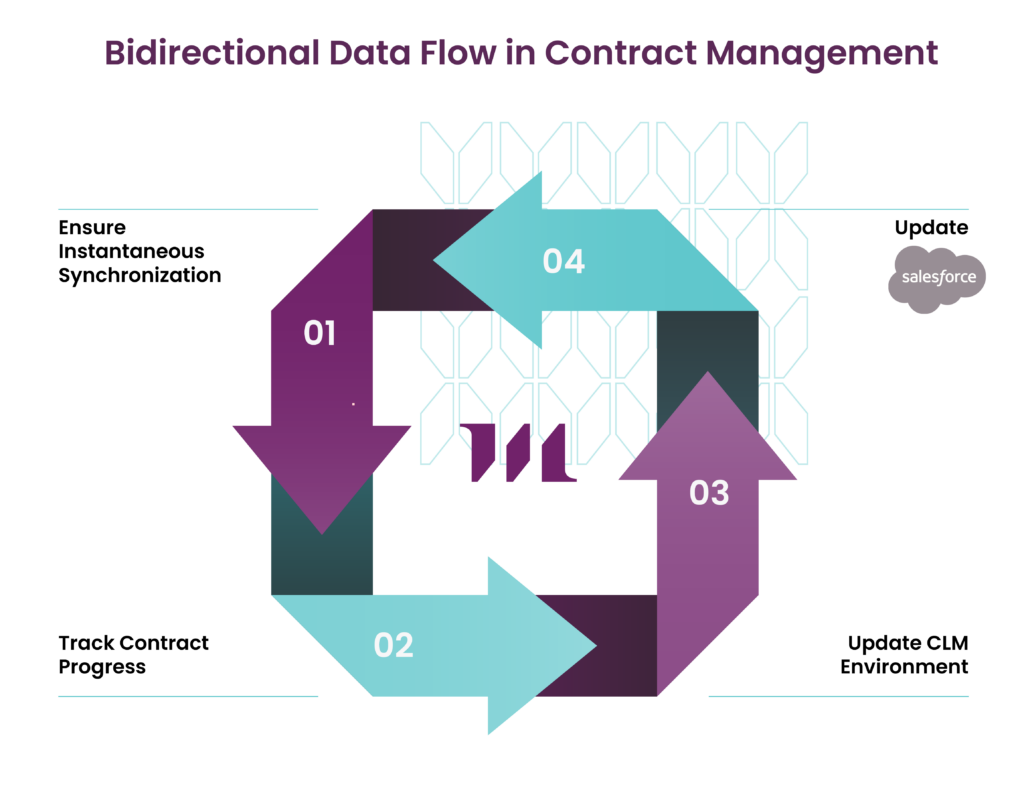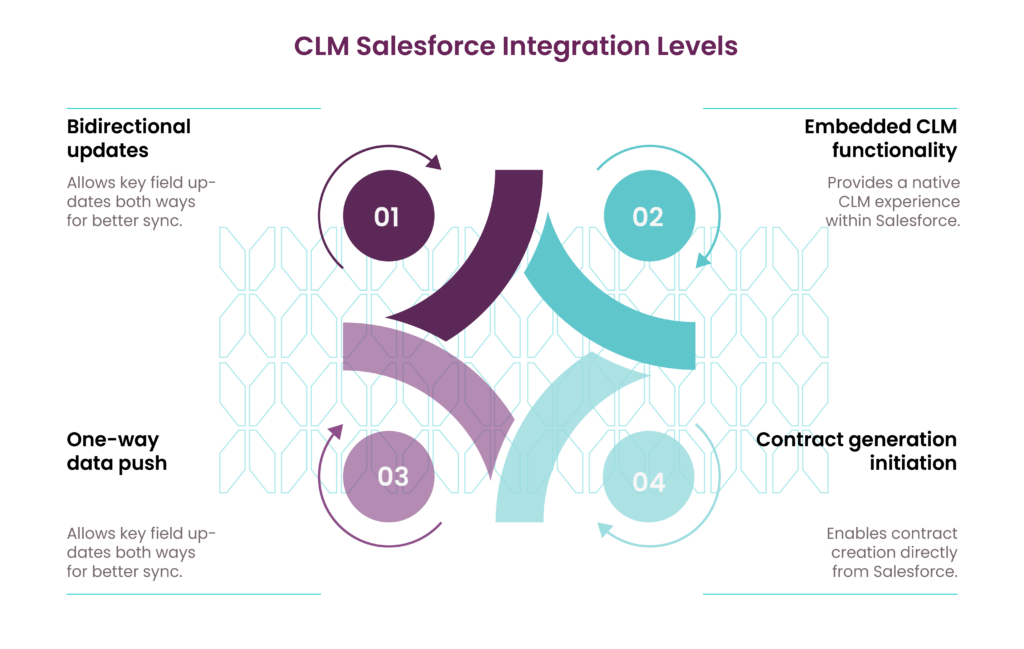Does your organization rely on Salesforce as the heart of your customer relationships? If so, you’ve likely encountered challenges when managing the contracts that formalize those relationships. While Salesforce excels at tracking sales opportunities, it wasn’t specifically designed to handle the complex requirements of contract lifecycle management (CLM). This disconnect creates friction that slows down your deal closures, increases risk, and frustrates both your sales and legal teams.
As your contract volumes grow alongside business complexity, you might be discovering what many organizations already have: integrating specialized contract lifecycle management software Salesforce solutions delivers transformative benefits across departments. Leading providers like Malbek offer purpose-built CLM solutions that seamlessly connect with Salesforce to address these exact challenges.
This guide explains how the right CLM for Salesforce can eliminate bottlenecks, reduce risk, and accelerate your revenue capture while keeping your sales team working in the environment they know best.
Understanding Salesforce’s Native Contract Management Capabilities
Salesforce dominates the CRM market, with IDC’s 2024 Software Tracker ranking it #1 for good reason. Its robust platform excels at tracking customer relationships, managing opportunities, and providing visibility into your sales pipeline. But when it comes to Salesforce contract management, the native capabilities offer only basic functionality – enough to store agreements as attachments and track simple metadata, but far short of what you need for comprehensive contract management.
Have you tried to manage contracts directly within Salesforce? Many organizations begin this way, creating custom objects, fields, and workflows to track agreements. This approach may work initially but quickly becomes unwieldy as your contract volumes and complexity increase. Your sales teams find themselves emailing legal for every contract modification, or worse, going rogue by reverting to unofficial templates stored on their personal drives instead of using pre-approved language. This creates significant downstream implications when organizations don’t know exactly what terms they’ve agreed to.
Limitations of Salesforce Contract Management
The platform was designed to optimize customer relationship tracking, not contract management workflows. Key limitations you’ll encounter include:
- No dedicated contract authoring environment, forcing your teams to draft in external tools like Word
- Legal bottlenecks and email back and forth for contract requests
- Limited template management with minimal control over clause libraries and approved language
- No automated contract generation from opportunity data
- Inadequate version control and redlining capabilities
- Minimal support for approval workflows specific to contract management
- Lack of specialized analytics for tracking contract cycle times and risk factors
- No AI-based review capabilities for contract analysis
These gaps force your teams to create makeshift processes that introduce delays, increase risk, and frustrate users—precisely what contract management is supposed to prevent.
The Gap Between CRM and Complete Contract Lifecycle Management
Beyond the general limitations of Salesforce for contract management, it’s important to understand the specific capabilities needed for truly effective contract processes. When teams try to stretch CRM beyond its purpose, they hit particular pain points: bottlenecks in legal workflows, lack of version control, compliance risks, and missed opportunities for process optimization.
Leading organizations recognize that contract lifecycle management platforms should extend—not replace—the CRM experience. Effective solutions provide specialized capabilities like clause libraries, template management, secure negotiation processes, and comprehensive version tracking that simply don’t exist in CRMs. The result? A seamless connection between front-office velocity and back-office rigor that transforms how contracts flow through your organization while preserving your investment in Salesforce.
Benefits of Integrating CLM Software with Salesforce
What happens when you connect a dedicated contract lifecycle management solution with Salesforce? You’ll see substantial benefits that impact your entire organization. By maintaining Salesforce as your system of record for customer data while adding specialized contract capabilities, you create a seamless experience that accelerates deals while reducing risk. This is precisely why contract management software that integrates with Salesforce has become essential for organizations looking to maximize their CRM investment. Malbek has developed its integration methodology specifically to keep contracts at the center of everything, connecting your legal processes to your customer relationships without friction.
The most impactful improvements come from eliminating the traditional disconnect between your sales and legal teams. Rather than forcing your sales reps to leave Salesforce and request contracts through separate channels, an integrated Salesforce CLM tool allows them to initiate, track, and even generate contracts directly from their familiar Salesforce environment.
Accelerating Sales Cycles through Seamless Contract Management
Aren’t contract delays among the biggest impediments to closing deals quickly? When your sales teams can generate contracts without leaving Salesforce, your cycle times shrink dramatically. Pre-approved templates populated with Salesforce data eliminate manual contract creation, while self-service capabilities for standard agreements reduce dependency on legal review.
Your approval processes become streamlined through automated routing to the right stakeholders based on business rules, and electronic signature integration accelerates final execution. Throughout the process, contract analytics help identify and remove bottlenecks, creating a smoother path to closure.
Improving Cross-Departmental Collaboration
The contracting process typically involves multiple departments, each with different priorities and concerns. A CLM solution connected to Salesforce creates a collaborative environment that transforms how your teams work together. Your legal department gains visibility into the sales pipeline for better resource planning, while sales representatives can see exactly where contracts stand in the approval process without leaving their familiar CRM. Finance teams access payment terms and revenue implications directly from integrated systems, procurement receives timely notifications about vendor obligations, and executives get comprehensive dashboard views of contract status and risks.
This collaboration happens naturally when contract data flows seamlessly between systems, with real-time updates ensuring everyone works from accurate information. Rather than repeated status requests and email threads asking, “Where’s my contract?”, all your stakeholders access a single source of truth about each agreement, eliminating the confusion and delays that plague traditional contract processes.
Enhancing Contract Visibility and Compliance
Risk management is difficult to achieve when contracts reside in multiple locations or as static attachments in Salesforce. CLM for Salesforce solutions dramatically improve your contract governance through a comprehensive approach to visibility and compliance. You gain a centralized contract repository with powerful search capabilities that make finding any agreement or clause a simple task. The system automatically identifies non-standard terms and deviations from approved language, alerting appropriate stakeholders to potential risks before they become problems.
Beyond initial contract creation, CLM systems track obligations to ensure all parties fulfill their contractual requirements. It sends expiration and renewal alerts that prevent revenue leakage from overlooked renewal opportunities and provides compliance checking against regulatory requirements and internal policies.
Essential Features of CLM for Salesforce
When evaluating contract lifecycle management software for Salesforce integration, certain capabilities stand out as essential for realizing the full benefits of a connected system. The most valuable CLM solutions combine ease of use for your sales teams with robust capabilities for legal and compliance functions.
Automated Contract Generation and Pre-Approved Templates
The ability to generate contracts directly from Salesforce opportunity data represents perhaps the single most valuable feature of a Salesforce CLM tool. This capability should include:
- Template libraries with pre-approved language for different agreement types
- Dynamic clause selection based on deal parameters like value, product, or region
- Automatic population of the customer and deal data from Salesforce fields
- Conditional logic that adapts contract language based on specific criteria
- Fallback provisions that handle exceptions gracefully
With this functionality, your sales representatives can create accurate contracts in minutes rather than days, dramatically accelerating deal cycles while maintaining legal compliance. Your legal teams benefit too, as they can focus on reviewing non-standard agreements rather than routine contracts.
Real-Time Data Synchronization Between Systems

Contract management with Salesforce requires a bidirectional data flow that keeps both systems up-to-date. When evaluating solutions, look for robust synchronization capabilities that ensure contract status updates appear in Salesforce opportunity records without manual intervention. Your ideal system should track changes and propagate modifications between systems automatically, maintaining consistent metadata management across platforms. The most valuable implementations also trigger workflows based on status changes and maintain historical tracking of all system interactions for complete auditability.
This two-way data flow ensures that your sales teams can track contract progress without leaving Salesforce while your legal and contract teams work in the specialized CLM environment. The best solutions make this synchronization near-instantaneous, eliminating delays and confusion about contract status that often plague manual processes.
AI-Enhanced Contract Analysis and Management
Advanced contract lifecycle management software with Salesforce integrations increasingly leverages AI to transform your contract processes. Malbek was built with AI capabilities from day one and utilizes an ensemble of leading-edge large language models that work together to provide better accuracy, relevancy, and reliable contract analysis results.
These capabilities go well beyond simple text search, offering automated extraction of key terms and obligations from third-party documents—a particularly valuable feature when reviewing customer papers. AI-driven risk analysis can identify potentially problematic clauses before they become issues, automatically comparing proposed terms against your corporate standards. Some solutions even suggest alternative language for negotiation, helping sales and legal teams respond quickly to counterproposals.
As your contract portfolio grows, pattern recognition capabilities become increasingly valuable, identifying trends across agreements that might suggest optimization opportunities.
Configurable Approval Workflows
Flexible approval routing represents another essential capability of effective CLM Salesforce integration. Your ideal solution should offer rule-based approval paths that adapt to contract parameters, sending agreements to different reviewers based on value, risk profile, or content. Look for systems that support both parallel and sequential approval options for complex agreements, allowing multiple stakeholders to review simultaneously when appropriate while enforcing proper sequencing when needed.
The best systems also offer delegation capabilities for handling approver absence and escalation procedures for stalled approvals, ensuring that contracts don’t languish waiting for review. Mobile-friendly interfaces for reviewing and approving on the go have become increasingly important as teams work remotely. The best CLM solutions allow your organization to model your actual approval processes rather than forcing them into rigid structures.
Selecting the Right Contract Management Software for Salesforce Integration
How do you choose the optimal CLM solution for your Salesforce environment? It requires careful evaluation of both technical and business factors. Beyond feature lists, you should consider how each solution will function within your specific contracting processes and Salesforce implementation.
Integration Depth Considerations

Not all CLM Salesforce integrations are created equal. The depth and sophistication of the connection substantially impact your user experience and adoption:
- Basic integrations may simply push data one way, from Salesforce to the CLM
- Moderate integrations allow bidirectional updates of key fields and statuses
- Advanced integrations enable contract generation and workflow initiation directly from Salesforce
- Premium integrations provide embedded experiences where CLM functionality appears natively within the Salesforce interface
When evaluating which contract management tool integrates best with Salesforce, examine how your users will experience the connection. Will they need to switch between systems? How much of the contract process can happen directly within Salesforce? Can they access contract details without leaving their familiar environment?
Scalability and Enterprise Readiness
As your organization grows, your contracting needs become more complex. The right CLM solution should scale alongside your business. Look for support for multiple contract types beyond standard sales agreements and the ability to handle increasing contract volumes without performance degradation. Your solution should offer flexibility to adapt to new business units, products, or geographical regions as you expand. Pay particular attention to support for complex organizational structures and permission models to ensure appropriate access controls as your team grows.
The most successful CLM implementations anticipate future needs rather than solving only current challenges. How would each solution accommodate your growth plans over the next 3-5 years? This forward-looking perspective helps you avoid implementing a system that you’ll quickly outgrow.
Implementation and User Adoption Factors
Even the most sophisticated contract management software Salesforce solution delivers limited value if your users resist adopting it. Consider the practical implementation factors that will influence success. How easy is the system to configure for administrators? Does it require extensive coding for customization, or does it offer no-code configuration options? Evaluate the interface from the perspective of both occasional and power users—is it intuitive and aligned with how your teams already work?
Training requirements and available educational resources should factor into your decision, along with realistic assessments of implementation complexity and time to value. Investigate the customer success support and professional services offerings available from each vendor, as these can significantly impact your implementation experience. Solutions that balance advanced capabilities with usability tend to deliver the highest ROI. The best CLM software should simplify your contract processes rather than add complexity to already busy sales and legal workflows.
Advanced Strategies for Maximizing Your Salesforce CLM Investment
Once you’ve established your CLM Salesforce integration, what’s next? Organizations with mature implementations can pursue advanced strategies to extract even greater value from their investments.
Expanding CLM Beyond Sales Contracts
While sales agreements often drive initial CLM adoption, have you considered expanding to other contract types to multiply the benefits?
- Your procurement department can leverage the same CLM platform for vendor management and supply chain optimization, tracking supplier agreements with the same rigor as customer contracts.
- HR departments benefit from managing employment contracts and confidentiality agreements in a secure, standardized environment.
- Real estate teams can track leases and property management agreements, while partnership teams manage distribution agreements in the same system.
- Even your IP team can benefit by managing intellectual property licenses and technology transfers through the CLM platform.
Each expansion brings new stakeholders into your system, creating a comprehensive view of all organizational relationships and obligations.
Supporting M&A Growth with Multi-Instance Salesforce Integration
Companies growing through mergers and acquisitions face a unique challenge: managing contracts across multiple Salesforce instances acquired from different organizations. Most CLM solutions can only integrate with a single Salesforce instance, creating data silos and forcing compromises in your contract management strategy.
Malbek offers seamless integration with multiple Salesforce instances simultaneously – a capability provided for years that remains rare in the market. This multi-instance integration capability allows your legal and sales teams to maintain continuity during M&A transitions while preserving the unique configurations of each acquired business unit.
The benefits extend beyond just technical integration. With multi-instance Salesforce connectivity, you can standardize contract processes across the enterprise while respecting the unique needs of different business units. Sales teams continue working in their familiar Salesforce environment while legal gains complete visibility across all contracts regardless of origin.
Leveraging Contract Data for Strategic Decision-Making
Advanced CLM users transform contract repositories from storage archives into strategic analytics engines. A robust contract database allows you to analyze negotiation patterns to identify frequently contested terms, potentially signaling opportunities to adjust your standard positions. Tracking price and discount trends across customer segments reveals insights about pricing strategies and sales effectiveness. Monitoring compliance requirements and regulatory changes affecting agreements helps you stay ahead of evolving obligations.
As your contract database grows, you’ll identify opportunities for contract consolidation and vendor management that can yield significant cost savings. Some organizations even predict renewal likelihood based on historical patterns and relationship factors, helping sales and account management teams prioritize their retention efforts. These insights enable data-driven decisions about everything from pricing strategies to risk management. When connected to Salesforce, they also inform your account planning and opportunity management with a contractual context that shapes future engagements.
Cloud Software Group Achieves 70% Faster Contract Cycles with Malbek
Cloud Software Group (TIBCO) exemplifies the transformative impact of implementing the right CLM solution for Salesforce. As a global leader in enterprise data that grows through M&A transactions, TIBCO faced significant contract management challenges with its legacy system. Due diligence required tedious manual reviews to identify unfavorable terms, while their multiple Salesforce instances from acquisitions needed seamless integration capabilities.
After evaluating multiple vendors, TIBCO selected Malbek as the only solution to handle their complex requirements. The implementation demonstrated what’s possible with the right approach:
- Contract cycle times decreased by 70% after Malbek’s implementation
- A complete global rollout was completed in just 4 months with zero code customizations
- Tens of thousands of legacy contracts were migrated with minimal technical dependencies
- System upgrades remained seamless with minimal downtime, even during heavy global usage
Multiple Salesforce Instance Integration with Malbek
Malbek successfully integrated with multiple Salesforce instances acquired through various M&A activities, a common challenge for growing enterprises. This integration allowed approximately 2,000 salespeople across three different Salesforce instances to access contracts directly from their familiar CRM environment.
Today, Legal, Sales, Finance, and Procurement teams at Cloud Software Group collaborate on a single platform. The robust Salesforce integration has transformed TIBCO’s contract management from a mere repository into a strategic asset that supports their growth strategy through AI-assisted contract review, reduced cycle times, and an actionable contract repository.
Wrap Up
Contract lifecycle management represents a critical capability for your organization if you’re using Salesforce as your CRM backbone. By connecting specialized CLM software with Salesforce, you can eliminate the friction between sales and legal processes, accelerate deal cycles, reduce risks, and gain valuable insights from your agreement portfolio.
Ready to begin your CLM journey? Start by assessing your current contract processes and identifying key pain points. Document your requirements with input from all stakeholders, including sales, legal, procurement, and finance teams. Research solutions with proven Salesforce integration capabilities, focusing on those that balance sophisticated features with usability and adoption potential. The success of your contract management Salesforce integration will ultimately depend on how well it addresses your organization’s specific challenges while providing a user experience that encourages adoption.
The success of the integration will ultimately depend on how well it addresses your organization’s specific challenges while providing a user experience that encourages adoption. Malbek’s seamless Salesforce integration, AI-powered contract analysis, and no-code configuration capabilities make it worth considering for organizations seeking to transform their contract management processes without disrupting their Salesforce experience.






